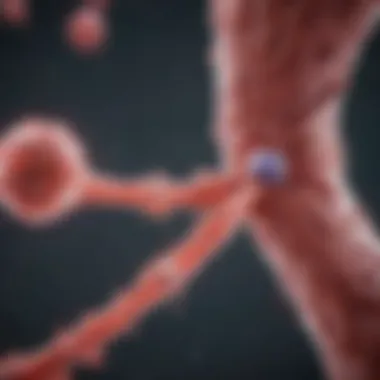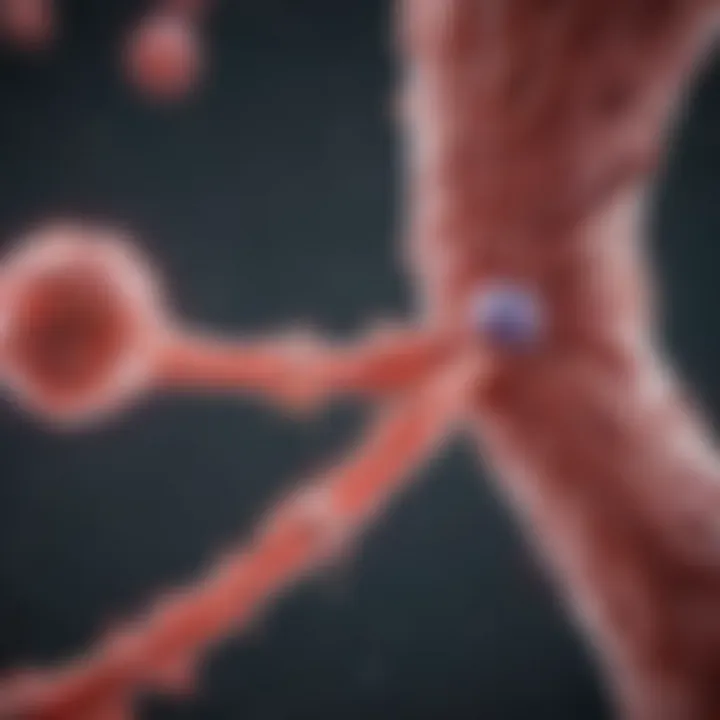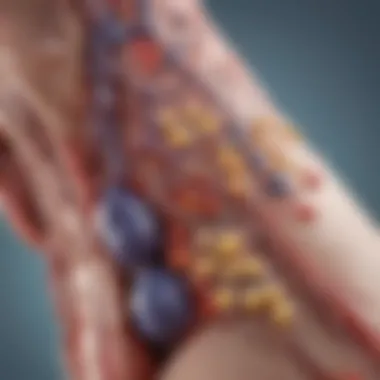Proteins and Their Impact on Arthritis Inflammation


Intro
Arthritis, a common yet complex ailment, often leaves individuals grappling with pain and restriction in mobility. At the heart of this inflammation lurk proteins, the unsung heroes—or villains—depending on perspective. Their role in the inflammatory processes associated with arthritis has sparked significant interest within the scientific community. Proteins can drive or dampen inflammation, making their study pivotal for both understanding the disease pathways and developing effective treatments.
This article unpacks the intricate relationship between these biomolecules and arthritis inflammation. With a focus on the biochemical pathways, we cover how proteins influence immune reactions and the subsequent inflammation. By doing so, we aim to bridge the gap between theoretical research and practical application in the realms of immunology and rheumatology.
Research Overview
Key Findings
The exploration of proteins in the context of arthritis has yielded notable insights. Some of the key findings include:
- Certain cytokines, like tumor necrosis factor-alpha (TNF-alpha), play a substantial role in enhancing inflammation.
- Interleukins, particularly IL-6, are pivotal in the signaling pathways that sustain chronic inflammation.
- Newer proteins, such as Pyruvate kinase M2, have emerged as central players in regulating immune responses.
Understanding these key players helps illuminate how therapies can effectively target particular pathways and potentially alleviate the symptoms of arthritis.
Study Methodology
Research in this field often utilizes a variety of methodological approaches:
- In vitro studies: Cell cultures are used to observe how specific proteins interact with inflammatory pathways.
- Animal models: Researchers frequently employ models of arthritis to gauge the effect of manipulating protein expressions.
- Clinical trials: Investigations in human subjects, focusing on how protein targets correlate with treatment outcomes, form a pivotal part of the research landscape.
Such comprehensive methodologies ensure a nuanced understanding of the proteins involved and their potential implications in therapeutic strategies.
Background and Context
Historical Background
The inquiry into proteins and their role in arthritis can be traced back decades. Early studies centered on immune responses to joint inflammation, leading to the identification of numerous key players, but often lacked clarity in the detailed mechanisms. Over time, with advancements in technology and techniques such as mass spectrometry, researchers began to untangle the myriad relationships between proteins and inflammation.
Current Trends in the Field
Today, there’s a significant push towards personalized medicine, where the unique protein profiles of individual patients could inform tailored interventions. Researchers are increasingly focusing on:
- The development of biomarker panels that could predict inflammation severity based on protein signatures.
- Gene editing technologies, like CRISPR, to study the impact of specific proteins on arthritis.
- Investigating the interplay between proteins and gut microbiota, contributing to systemic inflammation.
In a world increasingly shaped by advanced science, understanding proteins within the context of arthritis is ripe with potential. The narrative built here not only sheds light on the underlying mechanisms of the disease but also highlights avenues for innovative therapies.
Intro to Arthritis and Inflammation
Arthritis is a term that covers more than a dozen different diseases characterized by inflammation of the joints. Understanding this inflammation’s role is crucial for grasping how arthritis manifests, affects individuals, and cultivates potential treatment avenues. Recent research shows that proteins are central to this dialogue, acting like the gremlins that turn simple inflammation into chronic afflictions. So, digging into the role of proteins makes for a vital part of not only understanding arthritis but also mitigating its effects.
This discussion aims to dissect both arthritis and the inflammatory responses that accompany it, creating an important foundation for comprehending therapeutic strategies. We’ll explore the peculiar workings of various proteins, pointing out how they contribute to inflammation and interact within the body’s delicate ecosystem. Given the complexity of the immune system and its role in conditions like arthritis, a solid understanding of proteins offers both researchers and practitioners valuable insights into potential avenues for treatment.
Overview of Arthritis Types
Arthritis isn’t a one-size-fits-all label. It divides into numerous types, each with unique characteristics and underlying mechanisms. Among the most common types is osteoarthritis, generally seen in older populations or after joint injury. This condition is driven more by wear and tear than by the immune system making a fuss.
Rheumatoid arthritis, on the other hand, announces itself in a more aggressive manner. It attacks joint tissues through an autoimmune response, where the body’s defense systems, mistakenly identifying joint components as enemies, launch an attack. This kind of arthritis often goes hand-in-hand with systemic effects, impacting other organs too.
Other types include psoriatic arthritis, characterized by skin lesions, and gout, resulting from uric acid accumulation. Recognizing these differences is key, as treatment methods often hinge on which type one is dealing with.
Pathophysiology of Inflammation
Inflammation is the body’s natural response to injury and infection—sort of like an alarm system kicking in when things go haywire. In the context of arthritis, however, inflammation can spiral out of control. The pathophysiology of this process hinges on several interconnected biological mechanisms.
When tissues are damaged, the immune response is triggered, sending a mixture of proteins, cells, and signaling molecules to the scene. Cytokines, a category of proteins, play an indispensable role here by enabling communication between the immune system components.
This cascade of events may initially aim to repair damage, but if left unchecked, can lead to chronic inflammation. Elevated levels of inflammatory proteins like cytokines can cause prolonged joint degradation, leading to the weariness of cartilage and eventual joint dysfunction. To put it in simpler terms, what starts as the body trying to protect itself can morph into a relentless cycle of damage.
Understanding this pathophysiological mechanism is essential for developing effective therapeutic strategies. Mechanisms like these reveal the importance of proteins not merely as building blocks but as active players in the narrative of arthritis and its accompanying inflammation.
"The persistent inflammatory response can often become more damaging than the original injury, highlighting the need for targeted interventions to break this cycle."
By examining how proteins communicate and trigger inflammation, we can shed light on potential biomarkers for diagnosis and targets for new treatment strategies.
The Role of Proteins in Inflammatory Processes
Arthritis inflammation is a multifaceted process that involves a variety of proteins playing crucial roles. Proteins are not merely structural components of cells; they are also vital players in signaling pathways and immune responses. Understanding their role in inflammation provides insight into how arthritis progresses and the potential avenues for treatment.


Definition and Function of Proteins
Proteins are large, complex molecules composed of amino acids. They serve numerous functions in the body, including:
- Enzymatic functions: Proteins act as enzymes to catalyze biochemical reactions, speeding up processes that are essential for cellular function.
- Structural roles: They create frameworks within cells and tissues, thus maintaining the integrity and shape of cells.
- Transport functions: Certain proteins carry molecules through the bloodstream, such as hemoglobin transporting oxygen.
- Signaling: Some proteins transmit signals within and between cells, facilitating communication critical for immune responses.
In the context of arthritis, proteins like cytokines and chemokines are particularly significant as they direct inflammatory responses. They can promote or inhibit inflammation, influencing the condition's severity.
Significance of Protein Interactions
Proteins seldom act alone. Their interactions are pivotal for maintaining cellular and systemic homeostasis, especially during inflammation. Here are some key aspects highlighting the significance of these interactions:
- Cell signaling networks: Interactions among proteins trigger cascade effects. For instance, cytokine interactions can modify immune cell behavior, leading to increased production of inflammatory mediators.
- Feedback mechanisms: Proteins often exist in regulatory networks. For example, when pro-inflammatory cytokines like Tumor Necrosis Factor-alpha bind to their receptors, they activate signaling pathways that enhance inflammation. However, other proteins may inhibit this response, demonstrating a balance crucial for health.
- Impact on therapy: Understanding protein interactions has huge implications for treatment strategies. Biologics, for instance, are designed to target specific proteins in these pathways to mitigate inflammation and manage symptoms of arthritis.
"The network of protein interactions makes it clear that targeting one protein can resonate through the entire inflammatory process."
Key Proteins Linked to Arthritis Inflammation
When it comes to the intricate dance of inflammation in arthritis, understanding the role of key proteins is paramount. They serve as messengers, regulators, and executors of biological processes that either exacerbate or mitigate the effects of arthritis. In this section, we will delve into various proteins, primarily focusing on cytokines and chemokines, as well as inflammatory mediators. These proteins not only clarify the underlying mechanisms of arthritis but also pave the way for insightful diagnostic and therapeutic avenues. Their significance in inflammation dynamics cannot be overstated.
Cytokines and Chemokines
Cytokines and chemokines play a pivotal role in orchestrating the immune response, especially within the context of arthritis inflammation. They can be thought of as the conductors of an orchestra, influencing the behavior of various immune cells and guiding their actions. These proteins facilitate communication between cells, ensuring that the inflammatory response is neither too exaggerated nor too dampened.
Interleukins
Interleukins, a subset of cytokines, are integral to immune regulation and contribute significantly to inflammation. One particularly important type is Interleukin-1 (IL-1), notorious for its inflammatory properties. IL-1 encourages the activation of immune cells and amplifies the response to injury or infection.
A key characteristic of interleukins is their ability to stimulate the production of other inflammatory mediators. This cascading effect positions them as critical players in the pathogenesis of arthritis. Understanding interleukins is crucial for developing targeted therapies since they can be a double-edged sword—promoting healing but also perpetuating inflammation.
The unique feature of interleukins lies in their diverse functions, which can vary greatly depending on the context. While they foster necessary immune responses, unchecked interleukin activity may lead to chronic inflammation. The balance between beneficial and harmful effects highlights their complexity and importance in treatment pathways.
Tumor Necrosis Factor-alpha
Tumor Necrosis Factor-alpha (TNF-alpha) is another heavyweight player in arthritis inflammation. This cytokine is particularly well-studied for its role in promoting inflammatory pathways. Elevated levels of TNF-alpha are often found in patients with rheumatoid arthritis, making it a focal point in therapeutic interventions.
One notable characteristic of TNF-alpha is its ability to induce apoptosis in some types of cells, which might contribute to joint damage over time. As a consequence, TNF-alpha blocker therapies have emerged as valuable options for patients facing severe inflammation resulting from arthritis. The unique facet of this cytokine lies in its dual role: it can be a potent modulator of inflammation while also promoting tissue destruction in chronic conditions.
Inflammatory Mediators
Beyond cytokines, inflammatory mediators like prostaglandins and leukotrienes play substantial roles in mediating the inflammatory response seen in arthritis. These bioactive lipids fine-tune the inflammatory process, affecting how pain and swelling manifest in affected joints.
Prostaglandins
Prostaglandins are lipid compounds that have a wide array of functions in inflammation. They are synthesized at the site of injury and are integral to generating the symptoms often associated with arthritis, such as pain and swelling. Prostaglandins exert their effects primarily by promoting vasodilation and increasing vascular permeability, thereby encouraging the infiltration of immune cells.
One of the reasons prostaglandins are significant is their direct impact on pain perception. Nonsteroidal anti-inflammatory drugs (NSAIDs) operate by inhibiting the enzymes responsible for prostaglandin synthesis, effectively reducing inflammation and alleviating pain. However, this inhibition comes with potential disadvantages, including gastrointestinal side effects when used long-term.
Leukotrienes
Leukotrienes, another class of inflammatory mediators, emerge from the metabolism of arachidonic acid. They have a specialized role in the immune response, particularly in bronchoconstriction and the recruitment of leukocytes to sites of inflammation. Their involvement in arthritis is notable, as elevated levels can exacerbate symptoms.
A key characteristic of leukotrienes is their potent ability to enhance vascular permeability and promote mucus production, contributing to joint swelling and stiffness. This makes them essential players in both the pathophysiology of arthritis and the body's overall immune response. Importantly, medications targeting leukotriene pathways have been developed, providing new strategies for managing inflammation without the broader effects associated with some traditional therapies.
"Understanding the roles of these proteins allows for more targeted therapeutic approaches, potentially leading to improved management of arthritis in the future."
In summary, the exploration of proteins such as interleukins, TNF-alpha, prostaglandins, and leukotrienes reveals the complexity of inflammation associated with arthritis. Their various roles not only help decipher the mechanisms of inflammation but also present opportunities for developing more effective treatments geared toward specific inflammatory targets.
Mechanisms of Protein-Induced Inflammation
The intricate world of proteins and inflammation forms a backbone in the understanding of arthritis. Here, we unpack the mechanisms by which proteins incite inflammation, highlighting the paramount markers and pathways that play critical roles in this chronic ailment. Not only does it shed light on the biochemical processes involved, but it opens avenues for targeted therapies that could mitigate pain and enhance quality of life.
Signal Transduction Pathways
JAK-STAT Pathway
The Janus kinase-signal transducer and activator of transcription (JAK-STAT) pathway is pivotal in mediating the effects of various cytokines, particularly in the context of arthritis. In this pathway, once a cytokine binds to its receptor, it activates JAKs, which in turn phosphorylate and activate STAT proteins. These STAT proteins then translocate into the nucleus, where they regulate gene expression related to immune responses and inflammation.
One key characteristic of the JAK-STAT pathway is its speed. Unlike some other signaling routes that can take longer to engage, JAK-STAT activities can ramp up very quickly, thereby allowing for rapid cellular responses. This makes it a vital player in arthritis, where timely intervention could be crucial.


However, while it is frequently favored for its swift action, there is a drawback. Some signal amplification can exacerbate inflammatory responses if not properly regulated, leading to chronic inflammation, which is what we see in arthritis.
NF-kB Pathway
The nuclear factor kappa-light-chain-enhancer of activated B cells (NF-kB) pathway is another cornerstone in inflammation, particularly for rheumatoid arthritis. NF-kB typically resides in the cytoplasm in an inactive form, bound to an inhibitor. When activated, usually by pro-inflammatory signals or stressors, NF-kB sheds this inhibitor and translocates to the nucleus, consequently triggering the transcription of genes that drive inflammation.
This pathway is unique in its ability to serve as a central hub, integrating signals from various inflammatory stimuli, which makes it a beneficial focal point for understanding arthritis. Additionally, NF-kB plays a significant role in survival signaling, which is critical for maintaining continued inflammatory cell presence.
However, the intricate nature of NF-kB signaling can sometimes lead to sustained inflammation. Once it kicks into high gear, if regulatory mechanisms fail to keep it in check, it might culminate in a prolonged inflammatory state, which is detrimental in the context of arthritis.
Inflammatory Feedback Loops
Inflammatory feedback loops are crucial in maintaining and exacerbating inflammation. In the context of arthritis, positive feedback mechanisms can lead to a snowball effect, where the initial inflammatory cytokines trigger more cytokine production, thereby sustaining and amplifying the inflammatory response. This cycle can be remarkably resilient, making it hard to break without targeted therapeutic interventions.
Understanding these feedback loops is essential, as they reveal why some treatments might focus on disrupting these cycles to provide relief from chronic inflammation in arthritis. Treatment strategies often include medications that interfere with the signaling molecules involved in these pathways, aiming to reset the inflammatory state and restore balance.
In summary, mechanisms of protein-induced inflammation, through the investigation of signal transduction pathways and feedback loops, become critical knowledge not only for grasping the pathophysiology of arthritis but also for framing therapeutic approaches that can effectively disrupt detrimental cycles of inflammation.
Genetic Factors Influencing Protein Production
Exploring the genetic factors that influence protein production is crucial in understanding arthritis-related inflammation. Variations in genes can significantly affect how proteins are synthesized, leading to differences in inflammatory responses among individuals. Such genetic predispositions not only guide the severity of arthritis but also dictate how a person's body interacts with treatments. This intersection of genetics and protein production reflects the complexity of arthritis and illustrates the importance of personalized medicine in treatment approaches.
Role of Genetics in Arthritis Susceptibility
Genetics plays a pivotal role in determining an individual’s susceptibility to arthritis. Family history can often shed light on who might be more likely to develop these conditions. Specific genes, such as those associated with the immune system, can either amplify or mitigate inflammation. For instance, certain alleles of the HLA-DR gene have been linked to rheumatoid arthritis, influencing the activity of various proteins involved in the inflammatory cascade.
When considering genetics, it's not just about inherited traits. Environmental factors, such as lifestyle and exposure to particular stimuli, can interact with genetic predispositions to heighten the risk of arthritis. Understanding these dynamics is critical for researchers as they seek to identify new therapeutic targets or preventative strategies that attend to the genetic components of arthritis.
Polymorphisms in Inflammatory Protein Genes
Polymorphisms, or variations in DNA sequence among individuals, play a significant role in inflammatory protein responses. These genetic variations can alter the structure and function of proteins crucial in the inflammatory process. For example, single nucleotide polymorphisms (SNPs) in genes that encode cytokines may influence levels of these signaling proteins, which are essential for orchestrating the inflammatory response.
Research indicates that different polymorphisms can correlate with various forms of arthritis, leading to diverse clinical outcomes. Moreover, the presence of these polymorphisms may affect how patients respond to treatments that target inflammatory pathways.
"Understanding genetic polymorphisms can pave the way for tailored approaches to managing arthritis, as they hold the key to why some patients improve with specific therapies while others do not."
The study of polymorphisms in inflammatory protein genes is a burgeoning field. Advances in genomic technologies have opened new doors, enabling researchers to assess the interplay between genetics and protein production meticulously. Clinicians may soon leverage this information to develop individualized treatment plans that account for a patient’s unique genetic makeup, ultimately leading to more effective management of arthritis.
In summary, genetic factors are at the core of understanding how proteins influence arthritis inflammation. The role of single nucleotide polymorphisms and the broader implications of genetics on inflammation underscore the complexity of this disease and the necessity for continued research in the field.
Diagnosis and Biomarkers
In the realm of arthritis and its accompanying inflammation, the ability to accurately diagnose and monitor the condition is paramount. This section delves into the critical role of biomarkers and their significance in helping clinicians discern the presence and severity of arthritis-related inflammation. Identifying these biomarkers not only guides treatment strategies but also provides insight into the underlying mechanisms driving the disease.
With the myriad of inflammatory markers within the human body, honing in on the most relevant ones can significantly streamline diagnosis and management. By discerning subtle changes through these protein measurements, healthcare providers are equipped with the information needed to tailor treatment regimens effectively, ultimately improving patient outcomes.
Identifying Inflammatory Markers
C-Reactive Protein
C-Reactive Protein (CRP) stands as a prominent player among the inflammatory markers utilized in clinical settings. This protein is produced by the liver in response to inflammation and its levels can spike dramatically during active disease states. A key characteristic of CRP is its rapid response to acute inflammation, making it an incredibly beneficial tool for monitoring flare-ups in arthritis. It acts almost like a barometer, indicating when the body is experiencing an inflammatory process.
The unique feature of CRP lies in its sensitivity. Elevated levels can signal various states of inflammation, not limited to arthritis, thus providing a broader context to the healthcare provider. However, one downside to CRP is that it does not specify the source or cause of inflammation. It tells you something is wrong, but not exactly what or why, which might lead to further investigations and potentially complicate the diagnostic process.
Rheumatoid Factor
Rheumatoid Factor (RF) is another vital marker frequently tested in the evaluation of inflammatory arthritis, particularly rheumatoid arthritis. RF is an antibody that can be present in the blood and is often associated with inflammatory diseases. A hallmark of RF is its ability to provide a degree of predictability regarding rheumatoid arthritis progression, making it a staple in diagnosing this specific condition.
The particular strength of RF comes from its specificity to rheumatoid arthritis, which can aid in distinguishing it from other types of arthritis. Nonetheless, RF does present some challenges. It can also be elevated in healthy individuals or those with other autoimmune conditions, leading to false positives. This aspect raises important considerations about its clinical utility, prompting the need for further assessments in conjunction with RF testing.
Clinical Relevance of Protein Tests
Protein tests, such as those for CRP and RF, hold profound clinical relevance in the landscape of arthritis management. These tests not only illuminate the inflammatory status of the patient but also inform treatment efficacy over time. Regular monitoring of inflammatory markers can highlight trends that may necessitate therapeutic adjustments.
Moreover, understanding the implications of these tests can foster a more personalized approach to care, allowing for proactive engagement with the patient’s condition. This continues to be crucial in ensuring that treatments align closely with the individual’s trajectory through arthritic disease.
"With the right knowledge about inflammatory markers, healthcare professionals can navigate the complexities of arthritis diagnoses with greater precision."
Summary


Navigating through the intricacies of diagnosis and biomarkers allows for a more tailored and effective approach to managing arthritis. Understanding proteins like C-Reactive Protein and Rheumatoid Factor not only enriches the diagnostic toolbox but also enhances the conversation between patients and healthcare providers. As the field evolves, ongoing research may bring new biomarkers into the fray, offering even deeper insights into arthritis and its inflammatory driving forces.
Treatment Approaches Targeting Inflammatory Proteins
The treatment of arthritis has evolved significantly in recent years, placing a substantial focus on proteins that drive the inflammatory processes. Targeting these specific components is not merely a treatment method but a strategic approach that can lead to more effective management of arthritis symptoms. Understanding how proteins function in inflammation helps in developing targeted treatments that can mitigate pain and improve the quality of life for those affected.
Key Elements of Treatment Approaches
A combination of therapies is often employed to target inflammatory proteins effectively. Each treatment option comes with its own set of benefits and considerations:
- Biologics: These are derived from living organisms and specifically target components of the immune system, making them highly effective in inflammation control.
- Disease-Modifying Anti-Rheumatic Drugs (DMARDs): These medications help slow down disease progression and decrease inflammation over time.
- Emerging Therapies: Novel treatments are continually developing, aiming to address gaps in current therapy options.
The holistic approach to managing arthritis involves understanding individual patient needs, which drives healthcare professionals to tailor treatments effectively, pivoting on the key proteins involved in the inflammatory process.
Biologics and DMARDs
Biologics and DMARDs represent significant milestones in treatment, enabling targeted therapy.
Cytokine Inhibitors
Cytokine inhibitors play a pivotal role in managing inflammation by disrupting the signals that promote inflammatory responses. Their main characteristic is their ability to specifically block cytokines like tumor necrosis factor-alpha (TNF-α), which are notorious for wreaking havoc in arthritic conditions. This specificity is what makes cytokine inhibitors a popular choice among treatments.
- Unique Feature: They can dramatically lower inflammation levels in patients suffering from arthritis, improving functional capabilities and overall living quality.
- Advantages: Reduction in pain and disability, leading to increased physical function.
- Disadvantages: Potential side effects include increased vulnerability to infections, requiring careful monitoring.
Monoclonal Antibodies
Monoclonal antibodies, derived from a single clone of B cells, are customized to target specific proteins involved in inflammation. The key characteristic of monoclonal antibodies lies in their precision; they can latch onto specific proteins, impeding their action in inflammatory cascades.
- Why It's Beneficial: Given their targeted nature, they often exhibit fewer side effects compared to traditional treatments, making them a valuable option for many patients.
- Unique Feature: Their ability to be engineered to fit the specific inflammatory profile of a patient is a game-changer in personalized medicine.
- Advantages/Disadvantages: While effective, they are often expensive and require administration via injection or infusion, which can be less convenient for some patients.
Emerging Therapies
The landscape of arthritis treatment continues to change, with emerging therapies presenting innovative ideas. These therapies often look to target under-researched proteins or pathways involved in arthritis. Research is currently investigating:
- Small Molecule Inhibitors: These can disrupt critical protein interactions at a cellular level, offering new hope.
- Genetic Engineering Approaches: New techniques in gene therapy offer possibilities in modifying how proteins contribute to inflammation.
Overall, the horizon is optimistic, as ongoing research further enhances our understanding of proteins in inflammation and curates even more effective treatment options.
Future Directions and Research Implications
The study of proteins in arthritis inflammation is evolving at a rapid pace. With the complexities of the immune system and the multifactorial nature of arthritis, understanding the role of specific proteins can lead to innovative treatment strategies. Emphasizing research implications in this context is crucial. It not only aids in enhancing therapeutic options but also contributes to a holistic grasp of disease mechanisms.
Novel Targets for Therapy
Researchers are increasingly recognizing that many proteins previously overlooked may serve as novel therapeutic targets. For example, certain chemokines that guide immune cell movement are gaining traction. These proteins, when inhibited, could disrupt pathways that lead to destructive inflammation in joint tissues.
- Fibroblast Growth Factor (FGF): FGF has shown promise in promoting tissue repair and could be beneficial in limiting joint damage.
- Sphingosine-1-Phosphate (S1P): This protein influences the trafficking of immune cells and could be a key player in regulating inflammation.
Targeting these proteins can potentially yield new biologics that offer patients improved outcomes. Additionally, advancements in genomics and proteomics pave the way for more tailored therapies. Precision medicine, driven by individual protein profiles, may revolutionize how we treat arthritis, shifting focus from broad-brush approaches to specific pathways that are paramount for each patient.
Integrative Approaches in Research
The future of arthritis treatment lies not only in isolating proteins but also in understanding how they interact within broader biological contexts. An integrative approach combining biochemistry, molecular biology, and clinical practices can illuminate these connections.
Such an approach could look like:
- Collaboration among Disciplines: A partnership between rheumatologists, laboratory scientists, and geneticists can enhance research quality.
- Utilizing Data from Multiple Sources: Integrating findings from genomic studies, patient data, and environmental factors creates a more comprehensive understanding of how inflammation manifests in arthritis.
- Longitudinal Studies: Observing how protein levels correlate with disease progression over time can shed light on critical periods for intervention.
"As we continue to explore the intricacies of protein interactions, we are likely to uncover pathways that not only explain disease but also suggest practical strategies for intervention."
By maintaining an open dialogue among researchers and clinicians, we can enhance our collective understanding of arthritis. This will surely propel us toward more effective therapies and contribute to the well-being of those affected by the disease.
The End
The conclusion serves as a pivotal element of this article, drawing together the intricate threads that highlight how proteins act as core components in arthritis inflammation. By summarizing key insights, we can emphasize the significant relationship between proteins and the inflammatory processes that typify various types of arthritis.
Summation of Key Findings
Throughout this exploration, it has been made clear that proteins, particularly cytokines and inflammatory mediators, hold substantial sway over the progression and severity of arthritis. The roles of interleukins, Tumor Necrosis Factor-alpha, prostaglandins, and leukotrienes have been detailed, showcasing how these proteins orchestrate inflammation within the body.
- Cytokines like interleukins are instrumental in cell signaling, which drives the immune response.
- Tumor Necrosis Factor-alpha is identified as a crucial player in the inflammatory response, translating chronic inflammation into tissue damage.
- Prostaglandins and leukotrienes, as inflammatory mediators, exacerbate pain and swelling, indicating their role in arthritis flare-ups.
The discussion also illuminated the complexities involved in signal transduction pathways like JAK-STAT and NF-kB, underscoring how these processes may be therapeutic targets in arthritis management.
Implications for Future Research and Treatment
Looking ahead, the implications derived from this understanding of proteins in arthritis inflammation can profoundly affect how treatment plans are designed and implemented. Continued research into genetic factors influencing protein production could pave the way for personalized medicine, allowing a tailored approach to combatting arthritis based on individual genetic makeup.
The exploration of novel therapeutic targets, particularly in biologics, can maximize efficacy while minimizing adverse effects in patients. Such advancements hold the promise of elevating the standards for patient care, targeting the inflammation at its core rather than merely masking symptoms.
As we consolidate our understanding of the biochemical interplay between proteins and inflammation, we stand on the brink of innovation in arthritis treatment.
To summarize, recognizing the depth of protein involvement in arthritis inflammation not only enhances our academic but also our clinical strategies in addressing this widespread ailment. The future is ripe with potential for breakthroughs that could transform lives afflicted by arthritis.







